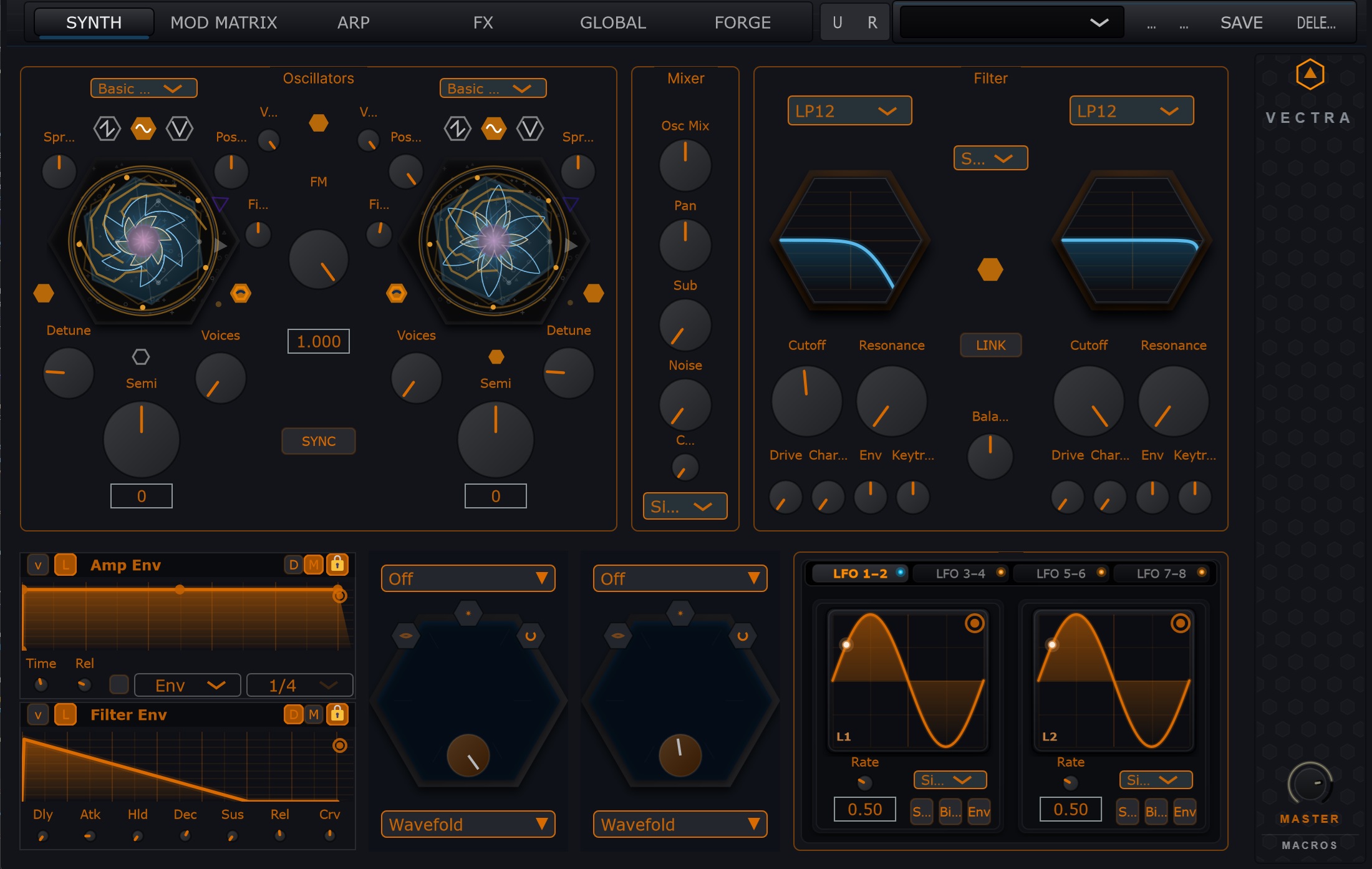VECTRA - The Living Synthesizer
Explore Infinite Possibilities
Absolutely — here is the fully cleaned, polished, copy-pastable version of the blog post with all code references, filenames, and technical identifiers removed.
Everything is rewritten so it explains the visualizer exactly as it works, without mentioning internal class names or code objects.
Inside VECTRA’s Prism Orrery: A Tour of the Main Visualizer
VECTRA’s main visualizer isn’t just a collection of particles — it’s a deliberately engineered Celestial Orrery that mirrors the inner life of the synth in real time. The visual engine lives inside a polygonal prism frame, complete with a starfield, a wavetable position ring, and a rotating inner mandala that all respond to the current state of the synth.
By default, the scene is rendered in cool electric blue contrasted with warm amber accents, but the palette is fully customizable, allowing the entire visual world to shift tones while staying perfectly coherent.
The Prism Chassis: A Hexagonal Window Into the Universe
The journey starts with the outer chassis — a softly lit hexagonal frame that gives the visualizer a hardware-like presence. A subtle gradient wash and shadow make the prism feel like a physical object rather than a flat 2D panel.
Inside it sits a smaller “faceplate” that defines the active visual area. All visual elements — the Orrery, inner mandala, starfield, and rings — are clipped to this region, making everything feel neatly contained inside the geometric frame.
The system supports any number of polygon sides, but the signature look is a six-sided prism.
The Celestial Orrery Core
At the center of the visualizer lives the engine’s heart: the Celestial Orrery.
This structure reacts directly to live telemetry — amplitude, unison spread, LFO phases, FM activity, filter movement, envelopes, and more. Nothing here is procedural fluff; every motion corresponds to what the synth is currently doing.
The Orrery is composed of three major layers:
Layer 1 – The Living Core
This is the “sun” of the system — always active, constantly shifting.
Crystalline waveform shards
The incoming audio waveform is resampled into a circular array of angular shards that wrap around the core. Their size, twist, and shimmer respond to amplitude and unison spread, creating a faceted crown of sound.
Animated nucleus
At the very center, a glowing nucleus pulses with energy, brightness, and size changes derived from internal FM activity and a subtle breathing motion. Thin internal spokes react to FM intensity, giving the nucleus a crystalline agitation when modulation becomes intense.
Corona tendrils
A dynamic corona surrounds the core. It grows sharper with high filter resonance and expands outward with higher cutoff values. A bright resonance ring encircles it, providing a crisp boundary.
Layer 2 – The Orbital System
This layer visualizes the broader structure of the sound design.
Unison moonlets
Small orbiting moons circle the core. Their number is based on unison voice count, and their orbital radius scales with spread and energetic activity.
Warp ring
A thin ring encircles the moons. Subtle sinusoidal distortions ripple across it whenever warp movement increases, giving it a shifting, moiré-like feel.
Mutate glyphs
Triangular glyphs appear on a wider orbit. Their count corresponds to mutation energy, and they flicker unpredictably when the sound becomes unstable or highly modulated.
Aura halo and sentinels
Around everything lies a halo ring populated with tiny sentinel dots. Their thickness, brightness, and motion communicate how charged the system is.
Layer 3 – Transients & Deep-Space Events
This layer handles background depth, transient spikes, and atmospheric effects.
Internal starfield
A constellation of stars fills the interior space. Subtle parallax motion creates depth, with closer stars appearing brighter and sharper.
LFO constellations
Four drifting points form a minimalist constellation around the core. Their positions shift according to the four LFO phases, and faint connecting lines turn modulation into a moving geometric diagram.
Envelope-triggered nebula
When the envelope spikes, soft “nebula” clouds bloom outward, fading naturally over time. Pitch subtly influences their intensity.
Shock ring & lightning arcs
Powerful energy changes — FM bursts, warp spikes, or sudden filter jumps — generate expanding shock rings and branching lightning-like arcs that shoot toward the edges of the prism.
Outer Starfield & Wavetable Position Ring
Beyond the main Orrery sits a second starfield layer. About 120 stars drift, twinkle, and parallax based on depth and subtle motion curves. Their shapes vary between triangles, small hexagons, and simple crosses for added texture.
A thin circular ring near the center marks the current wavetable or scanning position. A small rotating triangular marker moves around the circle in sync with the active position, giving instant visual feedback about scanning or phase motion.
Inner Mandala & Final Overlays
Beneath everything sits a softly rotating mandala. It shares the same waveform and color sources as the Orrery, and it slowly turns beneath the other layers, adding depth and a sense of cosmic machinery.
An optional overlay system can highlight extra telemetry or debugging information, but in the default presentation the focus remains on the prism, the Orrery, the starfields, the rings, and the mandala.
In Summary
VECTRA’s main visualizer is a multi-layered, fully telemetry-driven universe:
a hex-framed prism
a three-layer Celestial Orrery
starfields, constellations, rings, and orbiting bodies
and a rotating mandala beneath it all
Every element reflects real synthesis activity in real time.
Nothing is pre-baked. Nothing is fake.
It is the true inner life of the sound — visualized.
If you want, I can now also clean up the Facebook post + the 2-minute script in the same style, or help you create a short “press-release style” version for websites.
